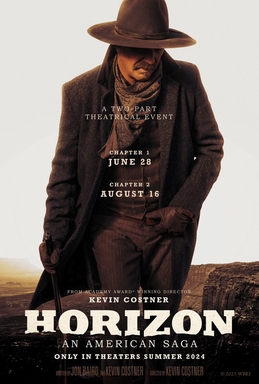
COSTNER’S WESTERN EPIC
Posted June 29th, 2024 at 8:10 amNo Comments Yet
CAMERA CAPTURES SEVERAL PICTURE PERFECT MOVIE MOMENTS
By PETER THOMAS BUSCH
The way the west was won was a long arduous journey filled with adventure and quite often death or, in the least, the risk of encountering great danger.
Director Kevin Costner brings together that spirit of those adventurers seeking to settle along the frontier from just about everywhere.
The first installment of this epic four part western story begins when Indigenous tribes still defended the lands in which towns were being built one by one in the years leading up to the Civil War.
Sienna Miller stars as one of the survivors of an Apache attack on a new community, half built out of tents along the river.
The story immediately has more death and vengeful hate in the script than love. But Frances Kittredge and her daughter, Elizabeth, played by Georgia MacPhail, move on with the protection of Union Soldiers.
The score drives many scenes as well as the picturesque landscapes and cinematography. Certain scenes are picture perfect with landscape, score and characters finding a magical synthesis in front of the camera.
Costner follows several unconnected narratives that may eventually join in Chapter 2 of the American Saga, as everyone involved seem to be heading to a new swath of land being advertised for settlement in Utah, the camera being lured by the marketing bills for Horizon.
Costner illustrates his knowledge of filmmaking by accelerating time and space at the end of the narrative in an effort to compel the audience to return for Chapter 2 at least.
But how everyone got there is more of an object lesson on how settling the Western Frontier, moving further and further west from places like Kansas, was a long journey involving hard work and confrontations with sordid unsavory characters who people in the wagon train might meet at any given juncture.
Exasperation is created at the slow pace of progress and with how what gains had been made on any given day could be wiped out in a heartbeat.
The director does not introduce Hayes Ellison, played by Costner, into the script until an hour into the 3 hr 1 m runtime for this first installment. When Hayes arrives in one of those picture perfect movie moments, the camera leaves the impression that everything will now begin to make sense.
Costner does create a kind of lawman, John Wayne character, but the storyline leads to yet another independent narrative, and another story of hardship and survival in a small town along the Western Frontier.
Abbey Lee plays Marigold, a lonesome lost sole being pushed about and ridiculed in a small town, as she waits for the right person to arrive that will take her away from everything, including the personal humiliation of living in nowhere.
Marigold picks out Hayes as the most handsome, stunning cowboy to arrive in town out of the newest group of riders to arrive. The exchange that brings Marigold and Hayes together creates a bit of relief, with the possibility that happier times are near. But the rawness of the West intervenes again and changes the destiny of everyone involved.
The competing interests of different groups of settlers is thrown into the narrative that runs parallel with a narrative about disaffection within the indigenous tribe, and their own shared difficulty identifying the wrongdoers among them.
One narrative broken off from the opening scenes, in which a new settlement is destroyed by an indigenous war party, has a group of cowboys continuing to search for the Apache party that killed men, women and children and burnt the town to the ground, but the search inevitably just seeks revenge against any indigenous peoples in their path.
This rising conflict foreshadows the Indian Wars that would continue on well passed the years that followed the Civil War.
A second narrative that branches off from the opening scene sequence involves Miller and Sam Worthington, as a Union Army Officer, as well as Danny Huston, as Colonel Albert Houghton.
The characters in this second narrative seem to be growing together as a community while in the deep background the Civil War has begun and the union soldiers in town get shipped off to the fighting, with heroic tales in their heads of eventually returning in honor. If only the soldiers knew then, what the audience knows now.
Chapter 1 does not really ever come together as a stand alone film. Instead, Costner only introduces everyone and the competing interests that seem to be destined to intersect in Chapter 2, which is scheduled to be released later this summer, on August 16, 2024.
But two more chapters are planned that, given the pace of the first chapter, may ultimately be necessary to more fully explain how the Western Frontier was settled.
Costner as star seems to personify Costner as director, a kind of slow methodical omniscient character, well aware of the dangers that may arise in the ensuing scene sequences.
There are many characters to work through, with the camera creating portraits of the Western Frontier from time to time, almost taken from the first black and white photographs created on silver plate.
The film would have done a bit better though, shortened by about 30 minutes for the theatrical release, without cutting any story lines, and by simply editing the scenes closer together into more of a montage.
Costner shows at the end that he knows how to do this, almost providing too much acceleration toward Chapter 2, leaving the impression that Chapter 1 was more of an object lesson in the slow grinding life, full of moral and ethical pitfalls.
